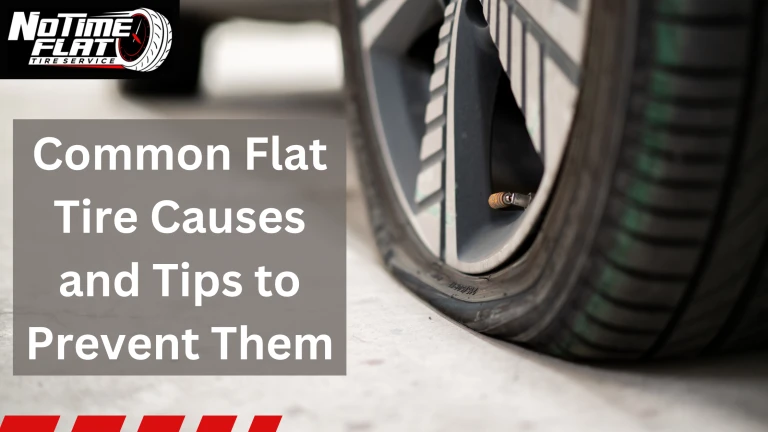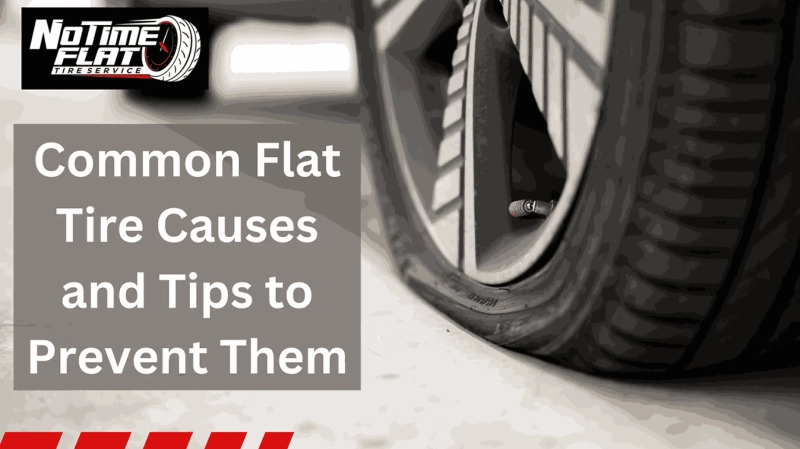
Flat tires are an unfortunate inconvenience that can disrupt travel and cause frustration. On average, people experience up to five flat tires in their lifetime. In the US, there are around 220 million flat tires each year, with tire punctures occurring at a rate of seven per second. So, this blog aims to provide common flat tire causes with valuable tips on preventing them and differentiating between a flat tire and one that simply needs air.
By understanding the flat tire causes and taking preventive measures, you will be able to reduce the likelihood of experiencing flat tires. If you find yourself with a flat tire, it is recommended to avoid driving and schedule an appointment with a mobile tire shop for prompt and efficient tire service at your location.
Flat Tire Causes You Need to Know
Have you ever wondered what causes a flat tire? If you frequently experience flat tires and wonder why this keeps happening, you\'re not alone. Once you identify the many common flat tire causes, you can proactively avoid future incidents and inconveniences.
Road Conditions:
Flat tire causes that are more common are those bad road conditions with nails, screws, glass, sharp rocks, and potholes. These hazards can puncture tires, leading to slow leaks or sudden blowouts. Potholes, in particular, can cause damage to tires, rims, and suspension systems. To avoid flat tires, stay alert while driving, avoid debris when possible, and reduce speed on rough roads or streets with potholes.
Tire Manufacturing Issues:
Although less common, tire manufacturing defects can result in flat tires. Stay informed about the tires on your vehicle and be aware of any recalls. Poor manufacturing can also lead to flat tires. Regardless of the cause, flat tires are inconvenient and can leave you stranded without a spare tire.
Underinflation of Tires:
Driving with underinflated tires is a major cause of flat tires. When tires lack proper air pressure, the sidewalls become vulnerable to damage, increasing the risk of punctures. Underinflated tires can also wear unevenly, reducing their overall lifespan. Regularly check tire pressure to detect any leaks or low pressure before they cause a flat tire. Proper tire inflation is essential for a safe and smooth ride.
Overloading of Tires:
Overloading beyond the recommended capacity puts excessive pressure on the tires and increases the risk of tire failure. Overloaded tires can overheat and become more prone to blowouts, especially during long drives. Pay attention to weight limits and ensure your tires handle the weight of your vehicle and its contents. It is important for pickup trucks and other vehicles used for heavy hauling. Staying within weight limits reduces the chances of experiencing a flat tire due to overloading.
Damaged Valves and Valve Stems:
Valves and valve stems play a crucial role in maintaining tire pressure. If the valves and valve stem become damaged or worn out, they can cause air leakage and lead to gradual deflation or sudden flat tires. Check the valve stem from a run-flat tire services provider if you notice no obvious signs of a puncture. A damaged or leaky valve stem can cause your tires to go flat.
Tire Bead:
The tire bead is also an important part of the tire structure. It\'s the lip that holds the rubber part of the tire to the metal wheel. If the tire bead starts to wear down due to age or other issues, it can cause tire failure.
Tire Aging and Wear and Tear:
Even without major damage, tires have a limited lifespan. The rubber compounds degrade as they age, reducing their strength and flexibility. This increases the risk of tire failure, especially in extreme weather conditions. Regularly check the condition of your car\'s tires and replace them before they become weak to prevent flat tires.
Extreme Temperatures:
Extreme heat or cold can affect tire air pressure. If you don\'t monitor your car\'s tire pressure during temperature fluctuations, it can lead to flat tires. When the temperature changes drastically, have a mobile mechanic check your tire pressure to ensure it\'s at the correct level.
Faulty Tire Maintenance:
Neglecting general tire maintenance, such as regular tire rotations, wheel alignments, and balances, can contribute to flat tires. Uneven wear and reduced tire performance can result from ignoring these maintenance tasks. Stay on top of tire maintenance with the help of tire services professionals to prevent a flat tire and ensure optimal tire performance.
Essential Tips to Prevent a Flat Tire
Preventing the above mentioned flat tire causes is necessary for a smooth and hassle-free driving experience. By following a few simple tips to avoid flat tires, you can possibly reduce the chances of encountering tire problems on the road.
Regular Tire Inspections
Regularly checking your tires is essential for maintaining their condition and preventing flat tires. Whether you inspect them yourself or have a mechanic do it, keeping an eye on your tires can help you avoid unexpected troubles down the road.
Tire Pressure and Tread Check
Maintaining the appropriate tire pressure is crucial for optimal tire performance and longevity. A tire repair services expert is best equipped to accurately measure the pressure and make sure that it falls within the recommended range. Checking the tire tread is equally important, and you can easily perform the penny test at home by inserting a penny into the tire tread grooves with Lincoln\'s head facing down. If you can see Lincoln\'s entire head, it\'s time to replace the tires, as they have become too bald for safe driving.
Spare Tire Inspection
You must not forget to inspect your spare tire, even if you\'re not currently using it. Identifying any issues or defects before you need to rely on them is crucial for your peace of mind. Promptly replace the spare tire if you notice anything wrong with it.
Avoiding Unsafe Areas
Avoiding certain areas can help prevent flat tires. Unpaved roads and areas near construction sites are more likely to have debris, such as nails, screws, and sharp objects that can puncture your tires. Regularly inspecting your car\'s tires for signs of wear or embedded objects is a good practice. Keeping your car\'s tires inflated to the manufacturer\'s recommended pressure provides better protection against road hazards. Remember to drive carefully near construction zones and on poorly maintained roads to minimize the risk of tire damage.
Brake Maintenance
Regularly checking your brakes is essential, as worn-out brakes can cause uneven tire wear, potentially leading to a flat tire. If you have concerns about your brakes, it\'s advisable to have them checked by a professional.
Tire Pressure Monitoring and Filling
Taking preventative measures is crucial for tire maintenance. Get your tire pressure monitoring service at least once a month and before long journeys. Keep a tire pressure gauge in your vehicle to monitor the pressure and fill the tires to the appropriate level as stated in your vehicle\'s manual or on the driver-side door frame. It\'s best to measure tire pressure when the tires are cold before driving for at least six hours. Typically, tires should run at 32-36 pounds of air pressure per square inch, with a maximum allowable pressure of around 44 psi.
Vehicle Weight Limitations
Being mindful of your vehicle\'s weight limitations is important. Avoid overloading your car with passengers or cargo beyond its maximum load capacity. Refer to your manual to determine the safe load capacity. Putting too much weight on your car can stress the tires, leading to quicker wear and flat tires. The maximum load information is usually found on the same label on the driver\'s door where you found the tire pressure recommendation.
Valve and Valve Stem Maintenance
During regular tire inspections, pay close attention to the condition of the valves and valve stems. If you notice any signs of damage or corrosion, have them replaced immediately. A regular maintenance check or a visit to your local mobile tire shop can help assess the state of the valve stem and replace it if necessary.
Inspecting The Signs of Wear and Aging
You must schedule regular tire inspections for signs of wear, such as cracking, bulges, or low tread depth. Tires that have reached their recommended service life or exhibit visible signs of aging should be promptly replaced to ensure your safety on the road.
Following the Recommended Maintenance Schedule
Following the tire maintenance schedule outlined in your vehicle\'s manual is crucial. Regular tire rotations and alignments promote even tire wear and improve overall driving safety. By avoiding fast starts and stops, getting your wheels aligned regularly, maintaining the recommended tire pressure, and getting your tires rotated on schedule, you can extend the life of your tires and reduce those flat tire causes.
Safe Driving Practices
Safe driving is always the number one preventative measure to protect your tires from bad road conditions. When driving on less than ideal roads, it\'s important to slow down your driving speed and maintain extra space between your car and the one in front of you. It helps minimize the impact of bad road conditions and reduces the risk of tire damage.
Be Proactive - Get Flat Tire Services Now!
Taking proactive measures, such as regular tire maintenance, monitoring tire pressure, and driving cautiously, can help you avoid the inconvenience and dangers of flat tires.
By understanding the common flat tire causes and implementing preventative measures with the help of a professional flat tire repair shop, you can ensure safer and smoother journeys while extending the lifespan and performance of your tires.
Stay proactive and enjoy the peace of mind with a reduced risk of flat tires.



